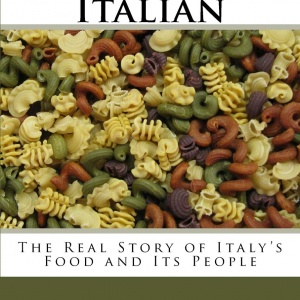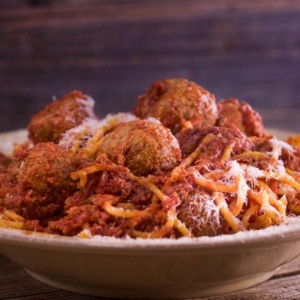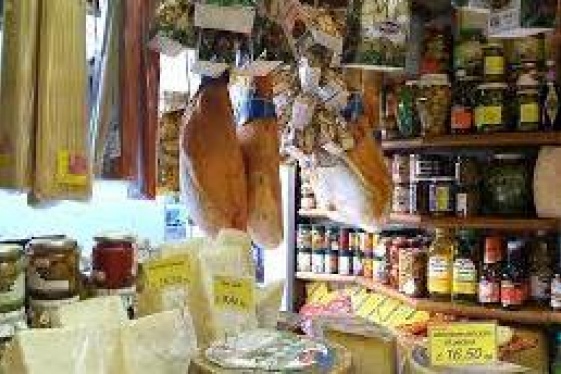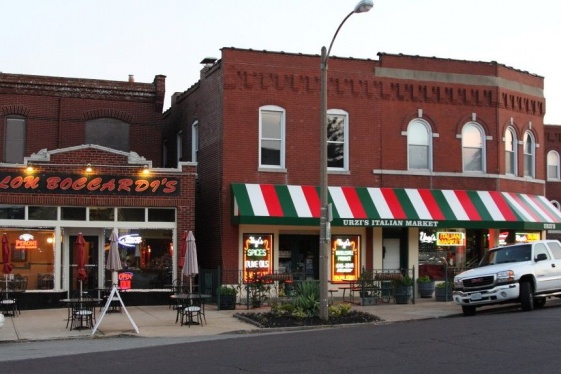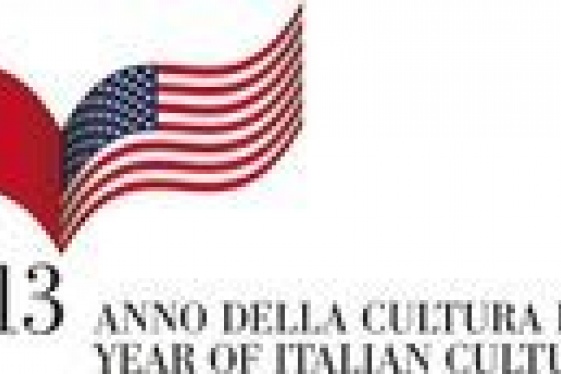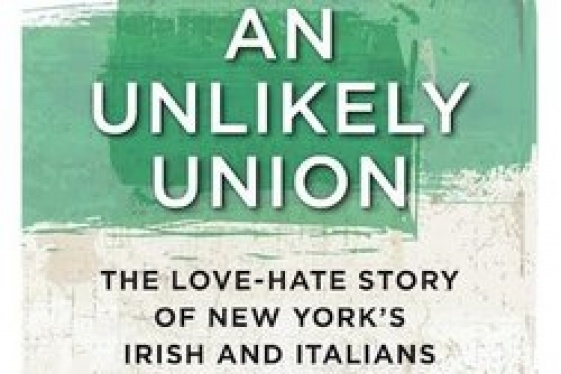
Dina Di Maio (Author of the book “Authentic Italian. The real story of Italy’s Food and its People”)
Un nuovo, interessante approccio verso la cucina italoamericana

Over the years, I have sometimes published interviews in which I do not completely agree with some of the answers. These interviews are among the ones I like most, because feeding the debate, helping to reflect and listening to different opinions is one of the most beautiful things that can be done by those who inform and communicate, in full respect of all and when the interlocutors are, as in this case, informed, competent, available, passionate and lovely.
Dina Di Maio is a young Italian American who has done a lot of interesting research and written a successful book on Italian cuisine in the United States, called “Authentic Italian. The real story of Italy’s Food and its People”. I thank her both personally and on behalf of We the Italians, because in this interview you will find things that come from the heart and the commitment in studying, whatever your opinion. I hope you will appreciate the contents of this conversation that I personally consider extraordinary and that has enriched my knowledge. And, by the way: in the million dollar question, "is it gravy or sauce?", for Dina it's gravy! Welcome to We the Italians, Dina!
Reviewing your book, Prof. Francesca Gobbo of the University of Turin wrote that you have the goal “to dispel the prejudices and biases about Italian immigrants and their food, by demonstrating and reclaiming the authentic Italian identity of the dishes prepared and cooked in the kitchens of Americans of Italian descent.” Let’s start with the prejudices and biases: can you please tell us about them?
There are prejudices and biases against Italian Americans and they carry over to our foodways. In the media, we are consistently portrayed as criminal and ignorant, which I believe stems from an undercurrent of prejudice towards us that has existed throughout the country since we started arriving in the mid-1800s, and which unfortunately, continues today.
Our ancestors were Roman Catholic, and there was suspicion and distrust of Roman Catholics in a predominantly Protestant country (which still exists to an extent today). Another reason was that the immigrants were enterprising and creating businesses that were seen as competition to already-established businesses here.
Everything about the immigrants became suspect—the food they ate, their religious festivals, their language. Many Italian people eventually thrived in this country, despite the hostile conditions. However, we have still not achieved a place of acceptance and respect in the United States.
The majority of movies and TV shows portray us as criminals and/or ignorant. They co-opt the dialects of Southern Italy, like Neapolitan and Sicilian, that our ancestors brought here. Italian American writers are often bypassed by commercial publishing unless they write books about organized crime, books that ridicule our culture, or books that romanticize Tuscany. This constant negative portrayal puts a bias in the minds of non-Italian people who come in contact with Italians in America in daily life, affecting how Italian Americans are viewed and treated to this day.
Is it any surprise that Italian American foodways are also in question? Every Italian American has come across the words used to describe our food: “invented in America,” “cheap,” “filling,” “overflowing,” “faux,” “not real,” “inauthentic,” “imposter,” “different,” “confusing,” “unlimited,” “a phenomenon,” “eat like a cow,” “swimming in sauce,” “drenched in sauce,” “red sauce joint,” “overloading,” “overpowering,” “too much garlic.”
What do these words mean to you? I don’t have to tell you they are not positive.
But to more specifically answer your question, some of the misperceptions include that the Italian immigrants were poor people who did not have access to imports or Italian food and made due with what was available in the United States. Not true! Yes, some immigrants were poor, others were skilled artisans, others were merchants, and still others were professionals. One of the first things they did when they moved here was create communities and open food-related businesses, importing products from Italy. And they carried on traditions of producing the foods they had been making when they lived in Italy.
Another is that all Italian American food is tomato-sauce based. Not true! Of course, the tomato is huge in Italian cuisine, especially Southern Italian cuisine. The majority of Italian immigrants were from Southern Italy, so the tomato is going to play a large role in Italian American cuisine (unlike in Argentinian cuisine, where the majority of Italian immigrants were from Northern Italy where the tomato is not a staple.) But I grew up on diverse Italian foods on a weekly basis, such as pasta soups and dishes like chick peas and pasta, peas and pasta, cannellini beans and pasta, lentil soup, pastina, pasta with anchovy sauce; vegetables with various preparations like escarole in soups or salads, broccoli rabe, broccoli, artichokes, chicory, dandelion greens, radishes and radish leaves, finocchio, zucchini in vinegar, eggplant parmesan, rolled eggplant, fried eggplant, eggplant with pasta; polenta different ways; many types of pasta like cavatelli, perciatelli, fusilli, mafalde, ravioli, rigatoni, strozzapreti, etc. with different sauces like aglio e olio, tomato sauce, ragù, Genovese; seafood like calamari, baccalà (fried or in salad with olives), clams, octopus, mussels; meat like veal cutlets, braciole, sausages, pizzaiola, dried and cured meats like capicola, soppressata; cheeses like fresh mozzarella, ricotta, provolone, pecorino romano, and ricotta salata; many egg dishes; breads like calzones, hard biscotti, long loaves, round loaves; and holiday foods like eel, struffoli, bowknot cookies, zeppole, zeppole di San Giuseppe, babà, pastiera, pizza chiena, casatiello, lamb with eggs and peas. We always have olive oil, vinegar, and salt to dress our salad—never “Italian dressing.” We always use pecorino romano cheese from Italy. We made coffee with an old Neapolitan coffee pot—we still use it, it was my great-grandmother’s. I could write a Neapolitan cookbook of my family’s recipes.
Another misperception that is often repeated is that there was a plethora of beef here, so Italian immigrants made large meatballs and ate a lot of beef. Not true! Italian American cuisine is diverse. Meatballs are made in the tomato sauce/gravy along with other meats like pork cuts, veal or beef, but they were an average size. In fact, we ate beef infrequently, and when we did, it was usually an American food like hamburgers or roast beef sandwiches. Also, Italians in Italy did eat beef, as is historically documented, which I also write about in my book, Authentic Italian. In fact, the name of Italy, Italia, comes from Fitalia, meaning “land of cattle,” the Greek name for fifth-century BC southwestern Italy, according to Valerio Lintner in A Traveller’s History of Italy. While the word “cattle” can include other animals, it most likely refers to cows.
Many Italians from Italy think that Italian Americans eat the same foods and courses as Italian American restaurants. Not true! Our Sunday dinner includes an antipasto, pasta, meat (often not even eaten) and then salad. We know that mozzarella sticks, garlic bread, pasta with vodka sauce, and Caesar salad are restaurant renditions of Italian food. Most of us refuse to eat at the popular Italian chains because we don’t consider them to be good quality.
I'm very interested about your opinion that “the cuisine of Americans of Italian descent in the United States is indeed Italian cuisine”. I am in love with everything Italian American, but I must admit I have a different opinion. I consider the Italian American cuisine as a tribute and an evolution of the Italian cuisine: but to me they are two different things. Please, convince me I’m wrong!
Umberto, I’m glad you brought this up. Many people share this view, and that’s one reason I felt compelled to write my book. We need to look at this issue beyond the obvious—food. It’s a deeper issue. When we talk about “Italian American cuisine,” what does that mean? To many, it means pasta dishes with “red sauce,” a term I don’t like to use because it is loaded with prejudice.
The majority of Italian immigrants to the United States were from Southern Italy, mostly Naples and Sicily. They brought their foodways, recipes, and traditions with them from those areas. However, there were Italians from many other regions, like Calabria, Basilicata, Apulia, Abruzzo, Piedmont, Liguria, etc., and they brought their particular traditions too. These people are referred to as “immigrants,” but they really were “refugees,” as they were fleeing terrible conditions in Italy in the late 1800s-early 1900s. That said, not all these people were impoverished. Many were educated people, as there was a problem with intellectual unemployment in Italy at that time, just like there is now in Italy and the United States. Many were also skilled artisans, be it in food or other craft.
When they arrived, they started creating communities—building businesses like grocery stores, produce markets, butcher shops, seafood stores, bread bakeries, pastry shops, pasta factories, restaurants. My great-grandfather had a restaurant in Italy and opened a butcher shop here in the United States where he imported products from Italy. Italian imports were big business. This is well documented and I provide many examples of this in my book, Authentic Italian. The Italians brought seeds here and planted their own gardens. They introduced Americans to different and new varieties of vegetables.
The immigrants settled in most of the major cities in the United States, with the exception of some of the Southern states, as the atmosphere was particularly hostile toward them there. Recently, the mayor of New Orleans apologized for the largest mass lynching in American history, of Italian immigrants. But there were other lynchings of Italian immigrants and much discrimination and hostility. In fact, Italian immigrants strengthened the celebration of Columbus Day by raising money for parades and erecting statues of Columbus because of harassment from groups like the Ku Klux Klan (KKK) that wanted to claim a purely Northern European founding of the United States.
There’s a misperception that Italians have been fully incorporated into American society, that there hasn’t been discrimination against us since Sacco and Vanzetti. I’m saying that this is not true. Italian Americans are maligned in the media on an almost daily basis. Our foodways are consistently discounted as “poor man’s food” when nothing could be further from the truth. We are constantly portrayed as belonging to organized crime, as lowlifes, or ignorant. Unfortunately, the North/South divide exists in America too. If it’s Tuscan or Venetian, it’s acceptable. If it’s Neapolitan or Sicilian, it’s low class.
Italian food is one of the most popular foods in the United States, yet the majority of articles about Italian food (and culture) are written by non-Italian people in the media. The media puts forth one script about Italian Americans, and this is repeated over and over as if it were truth. I am here to say, it is not truth. As with anything in life, to find the truth, you have to dig deeper. What’s even more unfortunate, is when you find an Italian American writer, chef, or personality who repeats these misperceptions without doing more research.
Well, I’m here to tell you, I did the research. I took four years of my life without a stipend, without a grant. I am not affiliated with a university. I have no restaurant, I produce no food product, I have no financial interest in any restaurants or restaurant groups, nor do I own stock in any. I decided to write this book because it was the right thing to do, to document the history of the Italian American people and their foodways for posterity.
Everyone knows the Italians love food, but I’m not sure everyone knows that a very Italian trait is to defend the oppressed and to seek justice. My book is vindication for the Italian American people. Italian American cuisine is the food of the Italian immigrant people, who were people of all socioeconomic classes. There’s an elitism in any discourse on Italian cuisine, and this has to stop. Hopefully, by writing this book and by confronting media outlets on social media—which as far as I can see, I am the only person doing this—I am helping to effect this change.
I want to see a day where the food of Southern Italian immigrants is not referred to in a derogatory manner but as what it is, Italian food made by Italian people who were displaced by politics.
Let’s talk about the past: how the Italian recipes brought with them by the Italian immigrants evolved in what they are now? Was it just a matter of necessity and impossibility to find the same ingredients?
I’m not sure where this myth got its start, but it is a myth that the Italian immigrants of 100 years ago did not have Italian ingredients and used what was on hand here in America to try to re-create dishes from Italy. One of the biggest of these myths is that there was a plethora of beef, so they used it to make large meatballs. I think this is absurd, and I’m wondering if this large meatball myth comes from the TV show about Rocco DiSpirito’s restaurant where his mother made very large meatballs. I grew up with, I would say, an egg-size meatball, and of course, it had breadcrumbs and other meats like pork and veal. (We also make tiny meatballs in soup and sometimes, lasagna.) This meatball myth is also ludicrous because meatballs are an ancient food and cross many cultures, including Indian, Turkish, Balkan etc. And they were eaten once a week, if that much, when the family had its large Sunday meal. And they were served with spaghetti, as I have found evidence in both 18th-century Italian literature and art, dispelling this myth that spaghetti and meatballs was invented in America.
Like I write in my book, Authentic Italian, the Italian immigrants who came to the United States created communities right away. They opened bread bakeries, pastry shops, meat markets, seafood markets, produce markets, restaurants, as well as non-food businesses. They did this in communities across this country, not only in big cities. They brought seeds over from Italy and grew vegetables like broccoli. Jacob Riis, a journalist who exposed the conditions of the poor living in New York’s tenements, even writes about an Italian seafood stand that sold fish that looked like it came from foreign waters. The Italians were importing products from Italy, and they were consuming these products. They were also producing Italian products here like pasta, cheeses like mozzarella and ricotta. They made sausages and cured meats. They grew grapes and made wine. Many of their descendants still do these things.
I think confusion is arising about Italian American food because newer Italian immigrants are judging it by what they find in most restaurants and in most American grocery stores today. Most of the chain restaurants are not serving what Italian Americans cook at home. Many privately owned Italian restaurants are not owned by Italian people. Many restaurants cut corners to stay afloat financially and this reflects in the quality. But I would say most Italian American people are growing, making, and/or buying quality Italian and Italian American made products to eat in their homes.
Which are the main dishes of the Italian American cuisine?
I think we need to define what is “Italian American cuisine.” There are two Italian American cuisines in the United States. One found in restaurants and one found in homes of Italian Americans. In restaurants, the foods are obvious like pizza, spaghetti and meatballs, ravioli, manicotti, ziti, cannoli, etc. Of course, Italian Americans make these at home too. But the second Italian American cuisine, the one made at home, is more diverse and reflects the regions in Italy where our ancestors came from. Italian food is regional even here in the United States. More Neapolitans settled in the New York area. More Sicilians settled in New Orleans and Chicago. The Genovese settled in California. So the traditions from their regions are reflected in the local cuisine. But Italian Americans are cooking all kinds of foods in their homes. I know Sicilians who make cuccidati, Waldensians who make soutisso. As I mentioned earlier, I grew up on and still eat diverse foods. Each Italian American family has its own traditions that were brought from the regions their ancestors came from in Italy.
What’s the future of Italian American cuisine?
This is an important question because it depends on a few factors.
One, the newer Italian immigrants, when they come to the United States and open restaurants, they are redefining Italian food in the minds of non-Italians here. That is hurting the legacy of Italian Americans whose ancestors came here over 100 years ago and who created Italian food and made Italian food one of the most popular foods on the planet. Now, there are people coming and saying, “This isn’t real Italian cuisine.” It’s confusing to non-Italians, who had a particular perception of Italian cuisine.
And I am noticing that many of these new Neapolitan-style pizzerias and contemporary Italian restaurants are owned by non-Italian people, or people who travel to Italy, take a course in gastronomy and come back and open a restaurant. There’s a great essay by Dakota Kim in Paste magazine: “We’re Having the Wrong Conversation About Food and Cultural Appropriation.” She says, “It’s not that you can’t cook another culture’s food. It’s the lack of examination of the complex power structure that surrounds that appropriation that’s unsettling.” I agree. There has to be consciousness, a real understanding of the racial, ethnic, and class issues -the sociopolitical history and implications of food production and consumption. If a privileged non-Italian person takes a trip to Naples, eats pizza at a few pizzerias and returns to the United States and opens a pizzeria serving Neapolitan-style pizza, their pizza does not have the cultural and historical significance of a descendant of the Italian immigrants whose family has had a pizzeria here for years. The former is purely a money-making business venture while the latter is truth and history.
Two, unfettered laissez-faire capitalism has been destroying the private, family-owned, “mom and pop” stores across the country for decades. The ones that are holding on are doing so with great difficulty. If we don’t go out of our way, which often means traveling to an area that may not be convenient to our home and work, we will lose these businesses because the owners cannot financially survive. We have to support our Italian American businesses, something I have been advocating on my social media for a few years now. And we have to continue to make the food of our ancestors in our homes, even though it is becoming increasingly difficult and expensive to find good, wholesome, natural ingredients. In general, the world has to take back its foodways from BIG FOOD. Two chefs who influence me are Michael W. Twitty, author of The Cooking Gene, and Sean Sherman, author of The Sioux Chef’s Indigenous Kitchen. They are reclaiming the cuisines of African Americans and Native Americans for the people, and that is what I hope to accomplish with my book. The definition of Italian food belongs to the Italian people, not to famous chefs, not to governments, not to manufacturers.
On the flip side, there is a strong grassroots movement in the United States to grow one’s own food, garden, buy from local producers and farmers, and create sustainable and fair trade products.
But I strongly believe the future of Italian American cuisine depends on the Italian American people. It is our duty to protect our heritage—to continue to cook, eat, and grow food in the same way our grandparents taught us. It is also our job to learn our history, to understand why we are here in America, and to defend our culture from the misinformation that occurs in the media on pretty much a daily basis.
How about pizza… how many different kind of American pizza are there?
The immigrants who came to the United States were primarily from Naples and Sicily, so they brought Neapolitan and Sicilian-style pizza with them to the regions of the United States where they settled. As opposed to Argentinian cuisine, where you find the fugazza, a focaccia-like pizza brought by the Genovese immigrants there. You will find this in the country’s pizzerias. In New York, Neapolitan-style was prevalent, and the famous pizzerias there like Lombardi’s still make that pie. In New Haven, Connecticut, the pizza is very similar because it was also created by Neapolitans like Frank Pepe. A coal-fired oven is used to create a crispy crust with a charred bottom. It is not wood-fired like pizza in Naples. When the immigrants first came here, pizza toppings were limited to cheese, anchovies, and onions. Sicilian-style pizza was a square, thick slice and it was cheese or with onions. I think you have to visit the classic pizzerias across the country to get a taste for the old world-style pizza like the ones I mentioned in New York. There’s O’Scugnizzo in Utica, New York, that is the second oldest pizzeria in the country after Lombardi’s. They make a tomato pie with grated cheese instead of mozzarella. There are a number of variations around the country, and I think that stems from where in Italy the immigrants came from and what kind of flatbread/pizza they had in their hometowns in Italy. Today, there are many pizzerias not owned by Italian Americans, and of course, the chain pizza places, but I don’t consider those real pizza and I don’t eat at them.
There are pizza aficionados who obsess about eating pizza and writing about pizza. And it is wonderful that the food of the immigrants is so beloved. Some of these fans claim there are many styles of pizza. I’ve read as many as 30. I’m not sure about this. To me, there are two styles, Neapolitan and Sicilian, and they can have slight variation due to the pizzaiolo’s technique. New York-style pizza is a variation of Neapolitan pizza made in a gas-fired oven. I’m a purist. I don’t like pizza with toppings. And for the record, Italian Americans scoff at ham and pineapple pizza just like the Italians do. (I confess I’ve had it, and it actually tastes good, but I still order mine plain.)
My parents owned a pizzeria in North Carolina in the 1980s when there were hardly any Italians in the state. It was not a good experience—I talk a little about it in my book. People were used to chain pizza. My parents actually made their own sausage, but the people didn’t want it. They wanted those frozen pellets the chain pizza places use. Today, many pizzerias are popping up in North Carolina; most are not owned by Italian people. Many claim to serve “real” Neapolitan pizza. I ask you, both sides of my family are from Naples. Who made “real” Neapolitan pizza in North Carolina? My family? Or the current non-Italian pizza shop owners?
What’s your favorite Italian dish?
This is an easy one. My mom’s fusilli with tomato gravy and a dollop of ricotta with some good crusty Italian bread. Another favorite of mine is the Neapolitan Genovese sauce with the beef and onions. We always serve it with perciatelli. It’s fabulous.
What do you think about the Italian sounding phenomenon, the products sold as they were Italian but made in different parts of the world and often with a very different flavor than the original Italian one?
I’m going to give you a very lawyerly answer: it depends. If these Italian-sounding products are being produced by descendants of Italian immigrants to those countries—like the United States, Argentina, Brazil—then I think they are no different from Italian products from Italy. If they are being produced by multinational corporations and labeled in such a way as to dupe the public into thinking they are made with quality ingredients and methods, no matter what country they come from—including Italy—then of course, I don’t agree with an Italian-sounding product.
There are millions of Italian descendants in the United States and Argentina alone, and they and their families have been producing Italian foods for decades—some 100 years—and they are Italian people. The only difference between them and native Italians is time and politics of place, as I say in my book. They are Italian and deserve to use the designation “Italian” to describe their products. Because it’s not only about the food being produced. It’s also about the history, why the immigrants left Italy to begin with, and what they came to in these new countries. Many faced hardships just for being Italian and for being Roman Catholic; therefore, it is impossible to divorce the food from the history. I don’t think anyone—a government or a corporation—has a right to tell any person of Italian extraction that they cannot use the word “Italian” to describe themselves or the food they produce. Governments and corporations should not dictate who gets to be Italian. The Italian people own that designation.
However, governments should be protecting consumers from products that are harmful or misleading. I want to make something clear: Italy produces many superior products. Italy is on the forefront in food integrity. I think the DOP designations help consumers to know how a product is produced. However, there’s the counter argument that many well-made and time-tested products in Italy do not qualify for DOP designation because they don’t fit the strict guidelines.
We have a crisis in the world right now in many ways, but especially pertaining to food. I struggle to find food that is food anymore. The ingredient lists are frightening. For example, genetically modified foods are increasingly added to our products. Soy in some form is in just about every product on the shelf, and if it’s not, it’s in vegetable wax and animal feed. Our dairy products are less and less “dairy” and more and more plant and tree gums and seaweed. I believe in the Slow Food Movement, which was started in Italy. I believe we need to voice our opinions about how our food is produced. Corporations are interested in the bottom line and what’s in the best interest of shareholders. That’s why we need to take an active role in food production and in safeguarding our foodways.
We the Italians is working on an Italian tribute, here in Italy, to the Italian American cuisine. An interpretation Italian style of the dishes prepared every day in the Italian American kitchens. What do you think about this idea?
I think this is a great idea. But remember that the majority of Italian Americans are descended from Neapolitan and Sicilian immigrants, so you will really just be having a Southern Italian meal. I would say that in conjunction with the food, the history of the Italian American people needs to be incorporated into the event. Perhaps a pamphlet or flier could be created to hand out to guests. I would be happy to write it for you and be a consultant to the chefs and organizers to give them the Italian American perspective and discuss the historical significance of the dishes. Whatever you decide to do, the message should be that we are not different, we are all Italian. I encourage readers to contact me with their comments and questions. My Twitter is @hunting4best
You may be interested
-
'Phantom Limb': A Conversation With Dennis...
Dennis Palumbo is a thriller writer and psychotherapist in private practice. He's the auth...
-
‘Fuggedaboudit’ the motto of new Italian del...
By Kimberly Sutton Love is what brought Tony Nicoletta to Texas from New York.The transpl...
-
“The Hill” St. Louis’ Little Italy
When the fire hydrants begin to look like Italian flags with green, red and white stripes,...
-
1st Annual Little Italy Cannoli Tournament
Little Italy San Jose will be hosting a single elimination Cannoli tournament to coincide...
-
A Week in Emilia Romagna: An Italian Atmosp...
The Wine Consortium of Romagna, together with Consulate General of Italy in Boston, the Ho...
-
An Italian American Feast For Family Reunion...
Hey, come over here, kid, learn something. ... You see, you start out with a little bit of...
-
An Unlikely Union: The love-hate story of Ne...
Award-winning author and Brooklynite Paul Moses is back with a historic yet dazzling sto...
-
Buon Appetito! Unique Italian dining at Ragú...
There's something to be said for having your food prepared tableside. Guacamole tastes fre...





